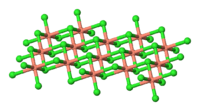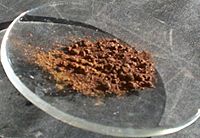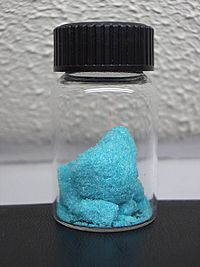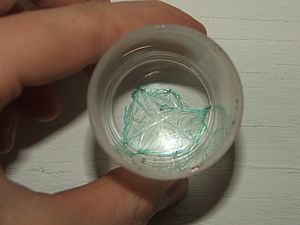Copper(II) chloride facts for kids
Quick facts for kids Copper(II) chloride |
|
|---|---|
 |
|
 |
|
 |
|
| Other names | Cupric chloride |
| Properties | |
| Molecular formula | |
| Molar mass | 0 g mol-1 |
| Appearance | yellow-brown solid (when dry) blue-green solid (with water) |
| Odor | odorless |
| Density | 3.386 g/cm3 (when dry) 2.51 g/cm3 (with water) |
| Melting point | |
| Boiling point | |
| 70.6 g/100 mL (0 °C) 75.7 g/100 mL (25 °C) 107.9 g/100 mL (100 °C) |
|
| Solubility | methanol: 68 g/100 mL (15 °C)
|
| Hazards | |
| NFPA 704 |
|
| Flash point | Not flammable |
| Except where noted otherwise, data are given for materials in their standard state (at 25 °C, 100 kPa) | |
Copper(II) chloride, also called cupric chloride, is a common chemical compound. Its chemical formula is CuCl2. This means it has one copper atom and two chlorine atoms. Copper(II) chloride is a type of salt.
Contents
What are the properties of copper(II) chloride?
Copper(II) chloride looks different depending on if it has water in it or not. When it is completely dry (anhydrous), it is a light brown solid. When it has water molecules attached to it (hydrated), it is a blue-green solid.
This chemical is a weak oxidizing agent. This means it can take electrons from other substances. For example, it reacts with aluminium foil to create hydrogen gas, copper(I) oxide, and aluminium chloride. This reaction is often shown in school science classes.
When you heat copper(II) chloride to a very high temperature, it breaks down. It releases chlorine gas and turns into copper(I) chloride. It also reacts with sodium hydroxide to form copper(II) hydroxide.
Copper(II) chloride can react with other metals. When it does, it forms new metal chlorides and pure copper. If you heat it in a flame, it produces a bright blue color. This is why it's sometimes used in fireworks. It can also react with sulfur dioxide to make copper(I) chloride.
When you dissolve copper(II) chloride in water, it creates a blue solution. If you add more chloride to this solution, the color changes. It turns green, and then yellow. This happens because different forms of the compound are created in the water.
How is copper(II) chloride made?
There are several ways to make copper(II) chloride. One way is to react copper metal directly with chlorine gas.
You can also make it by mixing certain copper compounds with hydrochloric acid. These compounds include copper(II) hydroxide, copper(II) oxide, or copper(II) carbonate.
Another interesting way to make it involves two steps:
- First, copper metal reacts with hydrogen peroxide (H2O2) to form copper(II) oxide (CuO) and water.
- Then, this copper(II) oxide reacts with hydrochloric acid (HCl) to produce copper(II) chloride (CuCl2) and water.
What is copper(II) chloride used for?
Copper(II) chloride has several important uses:
- It is used to make fungicides. These are chemicals that help protect plants by killing fungi.
- It is also used in organic chemistry to create different organic compounds.
- It plays a role in making acetaldehyde from ethane. Acetaldehyde is a chemical used in many industries.
Is copper(II) chloride safe?
Copper(II) chloride is considered toxic. This means it can be harmful if not handled properly. Its toxicity is similar to that of copper sulfate. It is important to always follow safety rules when working with chemicals like copper(II) chloride.
Related compounds
Images for kids
See also
 In Spanish: Cloruro de cobre(II) para niños
In Spanish: Cloruro de cobre(II) para niños





